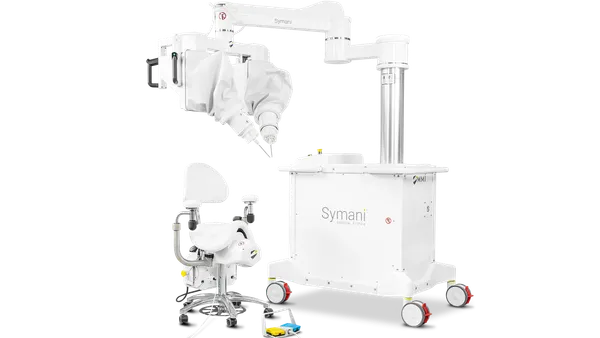Dive Brief:
- Patients who had a hysterectomy (removal of the uterus) or mesh hysteropexy (implantation of synthetic material supporting the uterus) to improve symptoms of vaginal prolapse experienced comparable efficacy and safety outcomes at three years, according to results from a randomized clinical trial published in the Journal of the American Medical Association Tuesday.
- Women implanted with mesh in the study had an 8% mesh exposure rate, a complication that can cause pain, bleeding, vaginal scarring and other problems that became a key subject of discussion at an FDA advisory committee meeting in February examining the devices' safety profile.
- Further research is needed to determine if one procedure is superior, the authors concluded. The National Institutes of Health, which funds the trial, said researchers will continue tracking outcomes until five years post-procedure. Boston Scientific, which was barred from selling its mesh product for pelvic organ prolapse patients by FDA in April, also provided some financial support through an unrestricted grant.
Dive Insight:
Months after FDA took a hard look at mesh's risks and benefits to pelvic organ prolapse patients, the authors offered a three-year outcomes analysis that "constitutes the longest duration of follow-up available" for a trial directly comparing mesh hysteropexy to vaginal hysterectomy with uterosacral ligament prolapse.
"Although transvaginal mesh procedures are controversial, few high-quality, long-term data compare apical transvaginal mesh with native tissue procedures," the authors wrote.
Both procedures are designed to reduce symptoms associated with weakening of the muscles and tissue supporting pelvic organs like the uterus, which can lead to those organs lowering into the vagina. Pelvic organ prolapse, or POP, is especially present in older women who have given birth.
While the mesh option may reduce the longer procedure time and risk for bleeding and infection associated with hysterectomy, mesh presents its own set of risks. Adverse event data on mesh repair for POP submitted to FDA between January 2008 and October 2018 included 806 reports of device malfunction and 77 reports of related deaths. The FDA review also found mesh erosion or exposure occurred in somewhere between 11% and 18% of patients with mesh implanted.
That body of evidence prompted FDA to reclassify the devices as Class III in 2016, but the cohort tracked in the NIH study had procedures done between 2013 and 2015, when the devices were still regulated in Class II.
Insufficient long-term data was a chief complaint among both clinical advisors and regulators when FDA examined mesh's risks and benefits for POP patients in February, and subsequently when the agency ordered remaining mesh products indicated for POP off the market in April, impacting manufacturers Boston Scientific and Coloplast.
"In order for these mesh devices to stay on the market, we determined that we needed evidence that they worked better than surgery without the use of mesh to repair POP," Center for Devices and Radiological Health Director Jeff Shuren said in the April announcement. "That evidence was lacking in these premarket applications, and we couldn't assure women that these devices were safe and effective long term."
The most recent NIH analysis was based on outcomes observed in 93 postmenopausal women who received mesh hysteropexy and 90 who had hysterectomy with uterosacral ligament suspension. In total, 169 participants completed three-year follow-up.
Researchers' treatment failure outcome accounted for re-treatment of prolapse, prolapse beyond the hymen, or prolapse symptoms, while secondary considerations included adverse events and operative outcomes. The authors determined the difference in failure rates between the two groups (26% for mesh, 38% for hysterectomy) was not statistically significant. The authors noted failure rates in the mesh vs. hysterectomy study are consistent with literature on native tissue repair.
Improvements in symptoms also appeared comparable, with 89% of hysterectomy patients reporting symptoms as "much" or "very much" better at three years, and 90% of mesh recipients reporting similarly.
"More long-term research is needed to determine if one procedure is better than the other," UC San Diego Health's Charles Nager, the lead author, said in an NIH news release.












